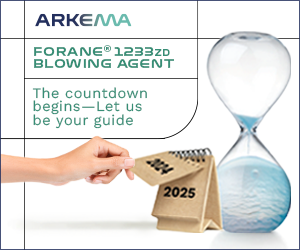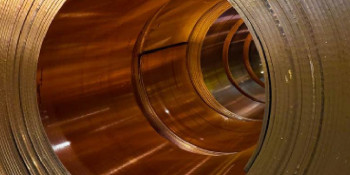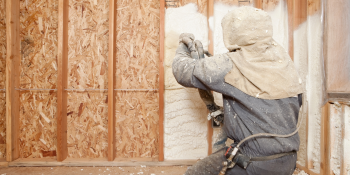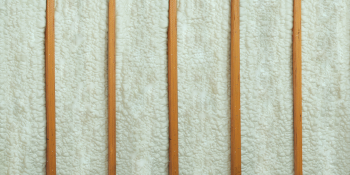Q&A Forums
Crawlspace Post New Topic | Post Reply
| Author | Comments |
|---|---|
|
Circle-D
Posted: Aug 16, 2010 04:21 PM
|
Crawlspace
Hi MikeI spray the underside of the floor on a lot of seasonal lakefront camps. Often these camps are built on posts and are open crawlspaces. Do they need a thermal barrier installed here? Is there any difference if it is an open crawl or if it is enclosed? The "occupied" space is actually above the floor. This sounds stupid but does anyone get so picky as to paint the TB on the floor before spraying the foam. This is the only way to get it between the foam and the occupied space. |
|
mason
Posted: Aug 18, 2010 07:56 AM
|
Mike, I am interested in your research on this matter. This is a question that I frequently had to answer while at SPFA and on my forum. The International Residential Code does not specifically cover the use of foam plastics in this type of application from a thermal or ignition barrier perspective. I contacted ICC staff and ICC ES engineers on the issue as well as a few well respected fire code officials. Their answers were not very illuminating. The code specifically states that all insulation in inhabited areas must have a thermal barrier but allows an ignition barrier in attics and crawl spaces. But, if the space is open on all sides as is the case where the house is on pilings, then do code officials consider that a crawl space or just an exterior application? The most common answer I received from the folks mentioned above is that the foam does not require a thermal or ignition barrier. It would have to be a 75 flame spread or better and a 450 smoke developed rating or better. In fire resistant construction, it would require a 25 flame spread and 450 smoke developed rating. They also said they would like to see the wood flooring pass an E 119 test because as the codes states, the foam plastic is allowed if a thermal barrier separates it from the inhabited space (or in its absence, fire tests that demonstrate the application does not require a thermal barrier element in the floor assembly.) Testing conducted in the mid 70s indicated that 3/4 inch plywood would typically pass an E 119 test, but I am not sure 1/2 inch plywood would pass. But code officials have interpreted this part of the code many ways, and some allow it without any covering and others require a thermal barrier over the foam plus any other possible combination in between. I would like to see a code change initiative that would provide more specific answers to this question. My personal view is that no thermal or ignition barrier would be needed if the floor was at least 6 feet off the ground and exposed on at least 3 sides and the wood flooring was 3/4 inch or greater in thickness. (However, depending on the height of the pilings and the degree of reflected UV, you may consider using a UV resistant coating over the foam. I have seen UV degradation on exposed sprayfoam applications even on the underside of flooring.) (NOTE: Typically this type of construction is done in flood zones and the IRC specifically requires that any materials used in flood zones must be flood resistant in accordance with FEMA Technical Bulletin 2. This bulletin specifically allows the use of spray polyurethane foam as a flood resistant material. Homes in flood zones listed in the codes are required to use flood resistant materials in order to qualify for home loans.) What do you think Mike. Am I off base? |
|
Circle-D
Posted: Aug 18, 2010 10:18 PM
|
Mason, Most of these camps are on 1'-3' crawlspaces. Around here if you can get 6 feet high you throw a basement under your building. They are open on at least 3 sides. The fourth side is generally on or very close to the ground. |
|
Posted: Aug 19, 2010 12:27 AM
|
Mason, I am going to have to approach this one from several perspectives. I am getting similar responses from "officials" as you mentioned, without absolute clarity. In my opinion, this is probably because floor materials can be viewed as part of the "enclosure", along with exterior sheathing and decking materials. As you know, this leads some to call everything on the outside of it an exterior application. (which is "logical") The oddity with flooring is that it is the only one of the three where INSULATION is positioned on the "exterior" side, when walls and roofs are obviously insulated on the inside. The Thermal Barrier issues are simple to comprehend on the walls & roofs/ceilings, but not so with floors. This is a good example of a confusing issue that was overlooked early on, and has not been clarified yet in the codes. I will be getting back to everyone with my evaluation soon, as I am inclined to study the "practical" issues, as well as the written codes on this one. For instance, as you note, 3/4" lumber can last 15 minutes in E119, but 1/2" plywood is a problem. Years ago, we conducted E119 tests on many types of 1/2" plywood, and the results varied widely, ranging between 6-12 minutes. Only a rare case lasted 15 minutes, so this is not reliable. My initial thought on the "practical" side is the fact that the prime issue with SPUF / Thermal Barriers, being "flash over", has completely different implications under a floor than a wall or ceiling. Heat rises, and every real fire is cooler at floor level, especially in the early stages of a fire... so, it might be practical in a "real world" sense to view the SPUF as an exterior application. Problem is, I can argue with myself on the other side of this as well, though I favor the above argument a bit more... I feel I should shut up at this point, because this is starting to sound confusing, and my goal is to try to "simplify" this stuff for the troops... Therefore, I need to study some issues, and give this some serious thought. Back soon. Mike Kiser |
|
mason
Posted: Aug 19, 2010 08:10 AM
|
Mike, I am glad to see that I am not the only sprayfoam "expert" who finds this issue confusing for a contractor and specifier. I am really looking forward to your input. Happy to see that you have tested 1/2" plywood. I haven't seen data from tests on it, so I was unsure whether it might pass the E 119 test. |
|
Posted: Aug 19, 2010 11:02 PM
|
(ok,,so its outside the structure,,, and this is different than a foam roof????rofl..this otta be good) |
|
Posted: Aug 23, 2010 05:46 PM
|
foamdude, Point taken! I am sure there are others who think this, so thanks for pointing this out. This lets me know that I need to clarify my INTENT further. I omitted roofing in order to keep things simple, and so we would not go into any circular arguments, or get too confusing. As I mentioned earlier, I was in the roofing business for over 20 years, and I saw that the Roofing aspect of the code is pretty well accepted and understood by the roofing industry. More to the point, I did not consider ROOF foam in this discussion because it has a completely different set of test requirements compared to wall, ceiling, floor insulations. This can get confusing, so I was intentionally avoiding it, for clarity. Therefore, I am only using the “insulation” aspect of foam (underside of roof deck) to make certain comparisons to help clarify everything about the floor. As you probably know, the test series specifically for roofing materials, including plastic foams, is ASTM E108, which is very much customized for roofing, due to risks that ONLY roofs have... fireworks, flying sparks, burning embers, or burning brands from “other fires” to keep them from spreading from roof-to-roof. Because of this, an ASTM E108 “Class C” is NOT anywhere close to what “Class C” means in other fire tests. I have seen materials that easily pass CLASS A flame spread with ASTM E-84 tests, yet fail CLASS C miserably when tested according to the “roofing” standard (ASTM E108). As anyone reading this so far sees, this can get very confusing, and I felt inclusion of roofs in this discussion adds nothing, yet would confuse many. (The very thing I am here to try to help clear up… “confusion”) So, I hope this helps explain why I am ONLY going to include insulation “under decks or ceilings, inside walls, and under floors” in this discussion about floor insulation. I think it is wise to discuss roofing SPUF separately, and I will be happy to do so. (Although I see there is a thread for that already! I haven’t had time to see if fire codes for roofing have been discussed, but I will.) As for me answering Skip’s original questions about SPUF under floors, Thermal Barriers, Ignition Barriers, crawl spaces, etc... I am still studying a few issues. The code does not “specifically” detail every aspect of this issue for floors (as it does for roofs). This means this can get very confusing, and I intend to simplify to the best of my ability! This one has a lot of interesting aspects to it! Skip, I shouldn’t be too long before I get back to you on this. Mike Kiser |
|
Circle-D
Posted: Aug 28, 2010 07:48 AM
|
Bump............ |
|
Posted: Aug 30, 2010 04:08 PM
|
OK, I guess that was a "nudge"! Here is what I have at this point... There is one person from whom I am awaiting input, but it probably won't change my answer here today, so here goes. First of all, the two simpler issues: (1) As a practical matter, you wouldn't be able to use a Thermal Barrier coating product between the SPF and the floor regardless, because every coating that makes "Thermal Barrier" claims is an "intumescent" coating, and they require empty space to allow for the intumescent expansion that is a primary function of those type coatings. You cannot restrict the expansion of such coatings and get the proper performance from them. (2) Although it is not written in stone, with only a 3 ft. height, and one side almost (or actually) touching the ground, you should treat this as a crawl space because for all practical purposes, it IS. This means using “foam”, or “foam + coating” that passed Ignition Barrier testing. Now for the complex part of this. Should you be required to place a Thermal Barrier between the foam and the interior when the foam is UNDER the floor in the scenario you describe? Since the codes do not address this, I decided it best to describe the "points" I am going to make in my proposal for a code amendment addressing this issue. Not to say this will go through, but I feel it is completely logical. I think the foam should be treated as an exterior material (as some already suggest). The first basic reason is because it is not specifically addressed in any Thermal Barrier section of the code, and can logically be considered to be installed on the “outside” of the building "envelope" so to speak. BUT, I have specific reasons, based on real world logic and fire test data, for my belief that this should be stipulated in the code. These reasons are: a) Heat rises, and the floor is always the coolest part of a room in a fire situation. b) In a fire’s first 15 minutes (escape time), the lower floor level is the LAST to heat up and is therefore the last avenue of escape. c) In order for the air temperatures at floor level to cause off gassing of the SPF, flashover would already have to be occurring in the room. (In other words, foam off-gasses at ~400°F. If the air at floor level is over 400°F it is already too hot for humans to survive and crawl out, AND it is within seconds of flash over in the room.) d) Therefore, off-gassing of SPF at floor level becomes irrelevant as far as being a contributor to the “time to flashover”, and therefore the survivable time in the room. It seems to me the above arguments would lead to treating the SPF under a floor as an exterior material, requiring an appropriate flame spread rating for the building type. This is because, even IF you did install a 15 minute thermal barrier between the SPF and the floor, it would not change the actual time to flash-over compared to an ordinary wood floor, because that wood floor, even if only 1/2" thick, does add several minutes to the time it takes to get the foam to off-gas, which means the foam under the floor would not add to the fire until well after flash-over has occurred in the room above. Just to be clear... Here is another way to look at this: If "bare" foam were on the floor, the air temperatures at floor level would have to reach about 400°F to start the foam off-gassing. When the floor air temperature reaches 400°F, the room is no more than a minute or two from flash-over at MOST. (I've never seen it take that long.) Now, add one layer of wood flooring to the above scenario, and the WORST CASE wood flooring would provide >5 minutes delay of heating up the foam, because the wood would be absorbing that heat. Therefore, the FLOOR SPF insulation would contribute to the room fire a full three minutes AFTER flash over had occurred. In other words, foam under a wood floor, as the scenario you describe, is not a contributing factor to flashover within the occupied space. I would emphasize that the foam should be a Class A SPF (E84 flame spread), so that it would not diminish the rating of the floor material, in case the wood flooring is required to be a Class A. I have presented similar "logic points" appeals to Fire Marshals for clients many times, and I have found most to be very receptive if the arguments are sound. Especially in cases like this where the codes do not address the particular issue. At this stage of the game, you will have to appeal to your local official, and abide by his decision. I think the above points will help you. Mike Kiser |
|
Circle-D
Posted: Aug 30, 2010 07:49 PM
|
Thanks Mike, Wow, that was along way around to "no".LOL |
|
mason
Posted: Aug 31, 2010 09:02 AM
|
Mike, I would support a code change proposal of this type. In fact we might want to propose 2 of them. I could do one and you could too. I have found that at code hearings, there is a greater probability of getting support if more than one person is making a code change on the same issue. Too bad it can't go into effect until after 2012. There is another aspect to address from critics of the "exposed" foam under the floor in open ended crawl spaces. The plumber, welder whoever, under the house using a cutting or welding torch against the bare foam causing a flashoever of the foam. My response would be that because the crawl space is open, even if the surface of the foam flashed over, they could easily exit the area without harm. |
|
Posted: Aug 31, 2010 04:53 PM
|
Mason, I agree, so let's coordinate our proposals. As for your "welder" example, I have a lot of in house test data that supports that position. It is actually very similar to one of the most controversial arguments / positions I have taken in my past, which at first was met with "fury" from the Insurance Industry. (I showed that you cannot start a self-perpetuating fire with a torch on nylon carpet over a cement floor. I also stated that the REAL fire problem is "kindling", not structure.) When the Insurance commissioner came to "shut me down", I showed our tests and ideas, and they became converts. Hopefully, results will be similar with this issue. I guess it depends upon how many "critics" there are. |
|
steven argus
Posted: Aug 31, 2010 07:18 PM
|
I missed judged you Mike - again, sorry. But I'm still watching you! LOL. |
|
mason
Posted: Sep 01, 2010 10:53 AM
|
Sounds great!. I think we should get together on a call (571-239-5221) to discuss strategy and language. After that we should get Jesse Beitel onboard. He can help out at the code hearings when the critics get involved. |
|
mason
Posted: Sep 01, 2010 10:59 AM
|
Code change schedule for 2012/2013 cycle DEADLINE FOR RECEIPT OF CODE CHANGE PROPOSALS January 3, 2012 January 3, 2013 WEB POSTING OF “PROPOSED CHANGES TO THE I-CODES” March 12, 2012 March 11, 2013 DISTRIBUTION DATE OF “PROPOSED CHANGES TO THE I-CODES” (CD only) April 2, 2012 April 1, 2013 CODE DEVELOPMENT HEARING (CDH) April 29 – May 6, 2012 Sheraton Dallas Hotel Dallas, TX April 21 – 28, 2013 Sheraton Dallas Hotel Dallas, TX |
|
Posted: Sep 01, 2010 05:11 PM
|
Is it Mike or Flame Dude? Guinness thanks for the call back!! |
|
steven argus
Posted: Sep 02, 2010 03:30 PM
|
1 "n" please. So sorry Damian, nothing personal, its just that we get so many telemarketers and salesmen calling the answering machine. I can only assume you are trying to sell me something. (or yelling at me for some of my posts) Our advertising dollar is stretched as it is. We are very busy spraying foam and stay steady year round. I don't see the need for more advertising. Thank you. |
|
Posted: Sep 02, 2010 11:44 PM
|
mikey,, hey i know this is hillbilly,,but,, we sprayed a large customs lid assembly with 6 inches of closed cell foam... this was an "all metal" structure.. not a stitch of wood in her... well the guys went back up into the ceiling with their scissors lift and their stick welders and their wire welders and tacked in more metal for interior walls..and the spiral staircase in the 3 story plant atrium/arboretum...and to quote them "yeah dude,,the stuff would kinda burn and melt while we had the welder next to it..but it wouldnt spread..damn the smoke was stinkin stuff,,,never even had to use the fire extinguisher"...didnt "flash over",,,didnt burn the place down,,got pix of em doin it if you wanna see em...lol...i bout pooped my britches... by the way,,the owner had the "closed cell blinders" on and wanted 6" in 2x10 metal ceiling rafters in a conditioned lid assembly(drywalled flat ceilings below),,told him that the roof was gonna strip like my pooped britches at every metal roof rafter..."naw" he thought,,,"it aint gonna show thru this big buck rubber simulated shake roof",,,guess what,,???it sure as heck did that first winter,,and we went back and coved over the rafters with an open cell foam and it sure did fix the problem... |
|
Posted: Sep 03, 2010 11:20 AM
|
foamdude, I am not sure I am clear on your point (or question?). If I understand you correctly, you are making the point that the flames would not spread, even when exposed to the high heat of welding... and that is exactly the point I made in response to Mason's scenario with foam under a floor. As I stated, along with Mason, we plan to propose some code changes that take into account that foam will NOT flash over nor create "self perpetuating" flaming in an open space. The example you are giving demonstrates the same facts: You have to heat up the "air" around the foam to nearly 400 degrees F. before flames will grow significantly, or for flash over to occur. If the point is that perhaps there should be consideration in the codes to account for this "resistance" to flame spread, I addressed that with an analogy in my answers to mfrencher’s question under “Attic and Crawl Ignition Barrier”. I stated that, even though I think the codes have drifted from the original ideas for “ignition barriers”, being resistance to small flame ignition, I also said that the code writers have little choice but to take Flash Over into account, because if they write the code without considering it, there are scenarios that will, in fact, cause flash over in an attic, and a possible catastrophic event. Can’t let that happen. I gave ONE such scenario, but there are many. I’ve seen old heaters or water heater vent pipes ignite boxes in attics, which then would provide the 400+ degree air temps that could cause flash over. If the foam in said attic passed the ignition barrier test, that flash over would be delayed, giving more escape time. I hope this helps... but if the above was NOT your intended point / question, then I apologize for repeating my “other” answers, and I hope someone reading got something out of this review. In that case, please advise as to your intended question. By the way, I have been out of roofing for a long time... what in the heck is a rubber simulated shake roof? Just curious! Mike Kiser |
|
steven argus
Posted: Sep 03, 2010 11:33 AM
|
As I've said before, up here in the frozen tundra, we do not have water pipes, water heaters, or not much, if any, mechanicals in an UNconditioned attic. Even in a conditioned attic is there rarely any water pipes. If the attic temps reach 400 degrees, that would mean the floor beneath it is all ready a raging fire. (and hopefully every one is out) So what's the big deal if the attic foam does flash over? You know the firemen are going to be fighting the fire from the outside. We sprayed a house for a fireman last year. He said the first thing he will do, if his own house is on fire, is get up on the roof and cut through the roof and foam to let out the heat. Sorry for getting off subject, but I really hope the ICC will realize that we need real world testing. Not all situations are the same. |
|
Posted: Sep 03, 2010 02:48 PM
|
Mason, Sorry for the delay, but I've been absolutely buried here. I'll call soon, when I can set aside enough time to discuss this at length if needed. Mike Kiser |
|
Posted: Sep 04, 2010 11:29 PM
|
rubber simulated shake roof= shake type roof that is made out of rubber..recycled tires i believe,,look like shakes,,wear like tires... left overs make great mudflaps for the utility trailer..lol... |
|
jimcoler
I have over 10 years of experience specifying and installing open and closed cell spray foam. I've sold my business but I'm still selling for the new owners and consulting on large and custom specific jobs. I've expanded my knowledge into t Posted: Sep 22, 2010 07:47 AM
|
I agree with Guiness on this one. Once the foam has reached air temp of 400F, then there should be a big fire somewhere. The real point is to understand fire dynamics. So, Mike, what's your experience with Fire dynamics - The things that make fire go or stop? I personally beleive that fire can be inhibitted with foam to a much greater extent than with a non-combustible fiberglass. Just because it's stated that it's non-combustible, doesn't mean it won't melt and allow the fire to transfer through it to another area. This is what causes fires to spread and spread quickly! I think the codes have been turned upside down in this case because people don't want to take the time to understand fire and just take someones word for it. |
|
Daniel X
Posted: Sep 22, 2010 10:44 PM
|
Foamdude, why would you use 1/2lb. crap overtop of your 6" of good foam to fix the thermal bridging issue? Do you switch back and forth all the time? |
|
Posted: Sep 28, 2010 12:30 PM
|
guiness, Interestingly, I met a couple of fire fighters at the ICAA show, and this very subject was brought up by one of them. They both understood the flash over issues very well, and one of the scenarios that concerns them is the same one that I mentioned in another thread, and that is the idea of a fire growing “in the attic”. When they cut into an attic, the space can be Oxygen deprived due to a small-to-moderate fire using up much of the O2 in the enclosed space, yet the air is very much heated. When they cut the hole and introduce a fresh oxygen supply, there can be a sudden explosive result if the foam has been off-gasing in this hot, yet oxygen deprived situation. This, they explained, is a major concern. Their attitude is that “anything” that delays or reduces the level of off-gassing, would be ideal. In the scenario you describe, if the fire is actually in the room below, the air in the attic might be even hotter. I heard some real horror stories from those guys. This was THEIR input in that conversation. As for me, I have to point out that in code writing, the worst case must always be taken into account. The codes would not be nearly as effective at protecting people’s lives if they were based upon less than worst case scenarios. It is simply the nature of the beast, so to speak. I know it does at times create codes that become hard to understand, and that many will disagree with, but they DO make a viable attempt at taking everything into consideration, including concerns such as those pointed out by the fire fighters I spoke with at the show. You do have a point in that certain regions might be better served with some variations on the standard codes, but it is not my place to say. For instance, the State of Alaska might push for such a thing, but it would be difficult to find agreement politically, I think. Still... in prinicple, I do agree that this is certainly not perfected yet. My soap box at the end of the day is always the same... We must deal with the cards dealt to us, and we MUST do our best to keep everyone safe. Mike Kiser |




























